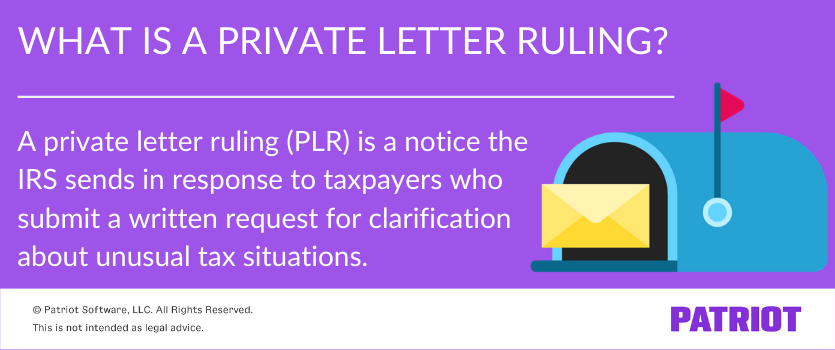Do you have questions about your tax situation that nobody can seem to answer? If so, you may need a private letter ruling from the IRS. What exactly is it, and how do you get it?
What is a private letter ruling?
A private letter ruling (PLR), or letter ruling (LTR), is a notice the IRS sends taxpayers, typically businesses, that submitted a written request for clarification about unusual tax situations. Taxpayers who have a question about a tax situation unaddressed or not addressed clearly in the tax laws can send a written request to the IRS asking for help.

The IRS PLR offers advice relating to the following jurisdictions:
- Corporate
- Financial Institutions and Products
- Income Tax and Accounting
- International
- Passthroughs and Special Industries
- Procedure and Administration
- Employee Benefits, Exempt Organizations, and Employment Taxes
To receive an IRS private letter ruling, you must submit a letter ruling request before filing returns or reports. Generally, private letter ruling explains how IRS rules apply to your specific tax situation and what you have to do to stay compliant with tax laws.
The IRS can remove personally identifiable information from private letter rulings and make them public.
When should you request a private letter ruling?
So, what are some situations that might prompt a PLR? Examples of when you might consider requesting a private letter ruling include situations relating to:
- Income taxes
- Gift taxes
- Relief for S Corps
- Employment and excise taxes
- Estate taxes
- Administrative concerns
- Changes in company tax years
- Changes in accounting methods (e.g., cash to accrual accounting)
When shouldn’t you request a PLR?
Depending on your situation, you may not need to submit a private letter ruling request to the IRS. Some examples of when you shouldn’t request a PLR include:
- Questions about an issue that’s under exam, consideration, or litigation
- Hypothetical situations
- Requests that don’t address your tax status, liability, or reporting obligations
- Questions that are answered in other published tax guidelines
PLR request procedure
How you submit your PLR request may change from year to year. Some things you must include in your request include:
- Name and business name
- Social Security number or Federal Employer Identification Number (FEIN)
- Mailing address
- Phone number
- Tax period(s) you have questions about
- The type of accounting method you use (i.e., cash-basis, accrual, or hybrid accounting)
- Complete details about the situation
- Supporting documents (e.g., contracts, wills, deeds, agreements, etc.)
- Other statements, as needed (e.g., whether the same or a similar issue was ruled on)
When submitting your request, include payment to cover the user fee. For 2020, user fees can range from $0 – $181,500.
The IRS may request additional information (within 21 calendar days). If they do, you have 21 calendar days from the date of their request to provide the additional information. If you don’t submit additional information, the IRS will close the letter ruling request.
Before submitting a request…
Not all taxpayers need to submit a letter ruling request to the IRS. If you’re thinking about it, do the following before submitting your request:
- Research: Look through tax laws to make sure the situation hasn’t already been addressed by a statute, revenue ruling, or notice.
- Consult an expert: Talk to your accountant or small business lawyer to see if they have an answer to your question. If they don’t, they may be able to help you put together your request.
- Don’t forget about fees: When you mail your PLR request to the IRS, remember to include a payment to cover the user fee.
- Use the IRS checklist: The IRS provides a checklist that taxpayers can use to verify they’ve included all of the necessary information in their request.
For more information on how you can submit a request for a PLR, consult the IRS’s website. Their Internal Revenue Bulletin: 2020-1 provides information on things like:
- User fee structure
- Sample format for a letter ruling request
- Checklist for requests
This year, get some extra help with your taxes. Try Patriot’s online accounting software to record transactions. Then, use the information you enter in the software to report to the IRS with ease. Start your free trial today!
This article has been updated from its original publication date of May 5, 2014.
This is not intended as legal advice; for more information, please click here.


